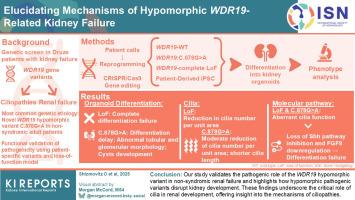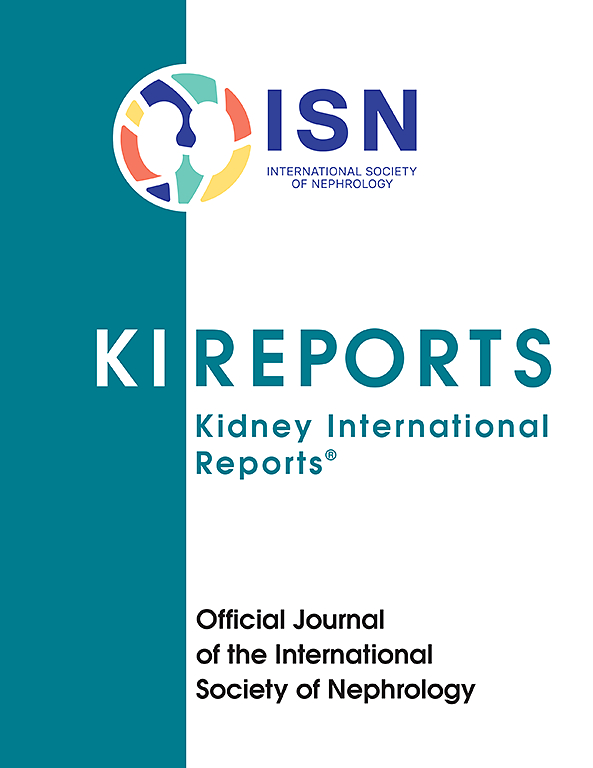Elucidating Mechanisms of Hypomorphic WDR19-Related Kidney Failure
IF 5.7
2区 医学
Q1 UROLOGY & NEPHROLOGY
引用次数: 0
Abstract
Introduction
Variants in the WDR19 gene, a crucial component of the intraflagellar transport (IFT) complex A, are associated with renal-cystic ciliopathies, a prevalent cause of renal failure of genetic origin. In the Arab Druze population, a WDR19 pathogenic missense variant (c.878G>A; p.Cys293Tyr, termed WDR19:C.878G>A) is the most common genetic cause of kidney failure manifesting as adult-onset, typically nonsyndromic chronic kidney disease (CKD). The underlying pathogenesis of this condition remains unclear.
Methods
We used CRISPR-Cas9 to induce patient-specific hypomorphic and loss-of-function (LoF) variants in human embryonic stem cells (hESCs), in addition to using patient-derived induced pluripotent stem cells (iPSCs) for differentiation into kidney organoids. Organoids were assessed by using immunofluorescence, electron microscopy, RNA-sequencing, and pathway analysis to elucidate the effects of these pathogenic variants on kidney development and ciliopathy characteristics.
Results
The WDR19 hypomorphic variant impairs nephron development, causing delayed kidney organoid differentiation from early stages, cystogenesis, and structural abnormalities in both tubular and glomerular structures. Mutant organoids displayed reduced ciliation and shortened cilia. Both mutated organoids exhibited Sonic hedgehog dysregulation, where the pathway was upregulated in the presence of severe LoF variant and significantly reduced ciliation. Elevated sonic hedgehog (Shh) signaling was associated with significant downregulation of fibroblast growth factor (FGF) 8 (FGF8) and transcriptomic alterations in associated pathways, suggesting an inverse pathways relationship during kidney organoid development.
Conclusion
Our study validates the pathogenic role of the WDR19 hypomorphic variant in adult-onset renal failure and highlights how hypomorphic pathogenic variants disrupt kidney development. These findings underscore the critical role of cilia in renal development, offering insight into the mechanisms of ciliopathies.

亚形型wdr19相关肾衰竭的机制研究
WDR19基因是鞭毛内转运(IFT)复合物a的一个重要组成部分,其变异与肾囊性纤毛病有关,这是一种遗传性肾衰竭的常见原因。在阿拉伯德鲁兹人群中,WDR19致病性错义变异(c.878G> a; p.Cys293Tyr,称为WDR19: c.878G> a)是肾衰竭最常见的遗传原因,表现为成人发病,典型的非综合征性慢性肾脏疾病(CKD)。这种情况的潜在发病机制尚不清楚。方法我们使用CRISPR-Cas9在人胚胎干细胞(hESCs)中诱导患者特异性的低形态和功能缺失(LoF)变异,并使用患者来源的诱导多能干细胞(iPSCs)分化为肾类器官。通过免疫荧光、电子显微镜、rna测序和途径分析来评估类器官,以阐明这些致病变异对肾脏发育和纤毛病特征的影响。结果WDR19亚型损害肾元发育,导致早期肾类器官分化延迟、膀胱形成以及肾小管和肾小球结构异常。突变的类器官显示纤毛减少和纤毛缩短。两种突变的类器官都表现出Sonic hedgehog基因失调,在严重的LoF变异和显著减少的介导下,该通路上调。sonic hedgehog (Shh)信号的升高与成纤维细胞生长因子(FGF) 8 (FGF8)的显著下调以及相关通路的转录组学改变相关,提示在肾类器官发育过程中存在反向通路关系。结论本研究证实了WDR19亚型在成人肾功能衰竭中的致病作用,并强调了亚型致病变异是如何破坏肾脏发育的。这些发现强调了纤毛在肾脏发育中的关键作用,为纤毛病的机制提供了见解。
本文章由计算机程序翻译,如有差异,请以英文原文为准。
求助全文
约1分钟内获得全文
求助全文
来源期刊

Kidney International Reports
Medicine-Nephrology
CiteScore
7.70
自引率
3.30%
发文量
1578
审稿时长
8 weeks
期刊介绍:
Kidney International Reports, an official journal of the International Society of Nephrology, is a peer-reviewed, open access journal devoted to the publication of leading research and developments related to kidney disease. With the primary aim of contributing to improved care of patients with kidney disease, the journal will publish original clinical and select translational articles and educational content related to the pathogenesis, evaluation and management of acute and chronic kidney disease, end stage renal disease (including transplantation), acid-base, fluid and electrolyte disturbances and hypertension. Of particular interest are submissions related to clinical trials, epidemiology, systematic reviews (including meta-analyses) and outcomes research. The journal will also provide a platform for wider dissemination of national and regional guidelines as well as consensus meeting reports.
 求助内容:
求助内容: 应助结果提醒方式:
应助结果提醒方式:


